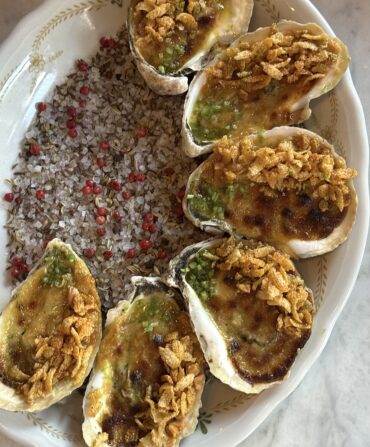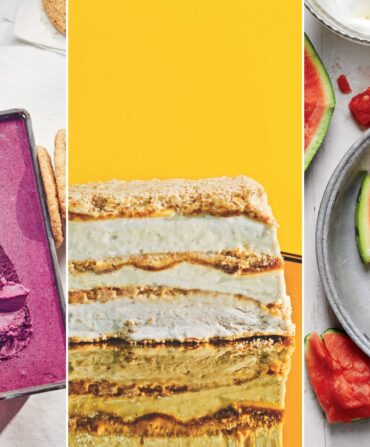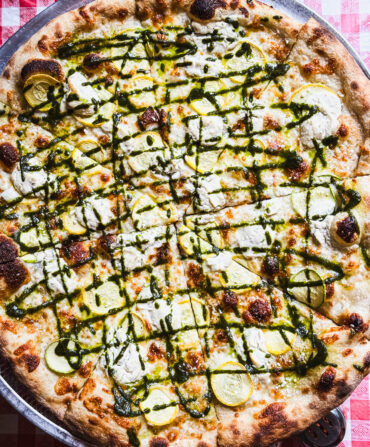With the annual Charleston Wine + Food Festival upon us, chefs, writers, and other food figures from all over the country have swarmed our sunny hometown with flasks and notebooks in hand. Southern food is still a powerful draw. But where is it going next?
We asked fifteen attending culinarians for their visions of the future.

Photo: Photographs by Peter Frank Edwards; Terry Manier; Johnny Autry
From left: Chris Shepherd’s chicken-fried short ribs; Mark Marhefka; Nashville-style hot quail.
Getting to know ourselves better
“I think it’s changing the definition of the word ‘local,’ looking at both ingredients and culture. Take shrimp and grits. We always had it on the lunch menu, because it’s a dish that people love. But it’s not us. There’s no reason why I should be doing food from the Carolinas in Houston. Now we serve slow-braised pork with caramelized fish sauce, lemongrass, and grits. A lady thirty miles away grows and grinds our corn for us, so I don’t have to get grits from out of state.”—Chris Shepherd, Underbelly, Houston
“When I first started selling oysters, everybody was talking about Daniel Boulud and Eric Ripert. Talk to young cooks now, and it’s all about Sean Brock, Ed Lee, and Mike Lata. It’s a big shift. All of us hate seeing KFC bastardize Nashville-style hot chicken, but it shows that people are more knowledgeable about our cuisine. It isn’t just pimento cheese and fried chicken anymore. Southern restaurants are opening all over the place now, but they’re representing more specific areas rather than caricatures. I think the future is going to be about spreading that knowledge.”—Travis Croxton, Rappahannock Oyster Company, Topping, Virginia
“The future is going to be all about local farms and farmers. Everybody is worried about who’s next. Right now, we’ve got Mark Marhefka of Abundant Seafood catching fish for us. What happens when he’s gone? Who’s taking over for him? There isn’t a line of people behind him.”—Nico Romo, Fish, Charleston, South Carolina

Photo: Photographs by Johnny Autry; Squire Fox; Rush Jagoe
From left: Jerk chicken at Cool Runnings in Houston; Charlotte; hummus at Shaya in New Orleans.
Stirring the melting pot
“Our region has always been about more than just corn and collards. Our future garden will be even more diverse, with everything from daikon radishes to heirloom beans our grandparents grew.”—Diane Flynt, Foggy Ridge Cider, Dugspur, Virginia
“The future looks like Charlotte, North Carolina. It’s the fastest-growing city in the state, and maybe in the whole region. There are chefs here doing awesome things, and lots of transplants not only from all over the country but also from all over the world. You take those cultures and bring them to a city already full of tradition, and you end up with something really interesting.”—Chris Coleman, the Asbury, Charlotte
“I’m seeing more influence from the West Indies and the Caribbean: curries, pepperpots, goat.”—Griffin Bufkin, Southern Soul, Brunswick, Georgia
“Did you know that the largest Kurdish population in the United States is here in Nashville? There are cultures here whose cuisines we haven’t even begun to enjoy, and that’ll change.”—Sarah Gavigan, Otaku Ramen, Nashville
“Southern food is becoming more diverse, with more ethnic influences. Just here in New Orleans you have Shaya and MoPho, run by chefs steeped in the world of fine dining. Nina Compton brought a Caribbean influence with Compère Lapin. We’ll be on this path for years to come.”—Ryan Prewitt, Pêche, New Orleans
“We’re bringing our diversity to the forefront, and it’s been an eye-opening experience for the rest of the country. I don’t think the way we’re eating now will always feel so… fusion-y. It’ll be like New Orleans, where influences from all over the world came together to make a cuisine.”—Duane Nutter, One Flew South, Atlanta

Photo: Photographs by Megan Rolfe; Johnny Autry
Dishes from Justin Burdett and Steven Satterfield’s Country Captain (center)
Finding new ways to cook—and eat
“Southern food is going to be more modern and technique-driven. The whole philosophy behind our menu is to give you something familiar that you might not recognize. ‘I’ve had these flavors together before, but I’ve never seen it done like this.’ For so long, it was all about the farm-to-table movement. It became a trend to buy really nice ingredients and do nothing to them. Now, we want to hold true to a lot of the things we grew up eating, but we want to present them in a more elegant way than the heavier mom-and-pop stuff we’re used to.”—Justin Burdett, Local Provisions, Asheville, North Carolina
“There’s a newfound trust in chefs, and that gives us more license to experiment with traditional dishes and flavors. People are also more food-focused than they’ve ever been. There is so much more information readily available, which takes away some of the mystery that is part of the restaurant business. We have to come up with new mysteries, like techniques no one has seen.”—Steven Satterfield, Miller Union, Atlanta

Photo: Photographs by Peter Frank Edwards; Lissa Gotwals; Eric Kiel
Sean Brock; the smokehouse at Sam Jones Barbecue; a pig at Carolina Heritage Farms in South Carolina.
Looking forward while looking back
“I think live fire cooking will continue to spread across the country.”—Sam Jones, Sam Jones Barbecue, Winterville, North Carolina
“We’re finding new ways to celebrate our ingredients. Take old-school stewed tomatoes and okra, which I’ve eaten all my life. We might take that dish to North Africa, making a tomato gravy spiced with fenugreek and coriander, and we might char the okra in our wood oven.”—Kevin Johnson, The Grocery, Charleston, South Carolina
“Our food will continue to get closer to the land. Pastured pork will lead the way, because it is exponentially better than the factory pork we’re used to.”—Wyatt Dickson, PICNIC, Durham, North Carolina
“As we continue to discover new ingredients and dig up old recipes from our respective regions, a couple of things are going to happen. You’ll have chefs who wouldn’t dare change a dish and you’ll have outsider chefs who will continue to evolve those dishes. I think they’ll balance each other out. I also believe that they are both essential. As long as we’re telling the stories and respecting the flavors, we’ll continue to make it the grand cuisine it’s been all these years.”—Sean Brock, Husk, McCrady’s, Minero, Nashville, Atlanta, and Charleston, South Carolina
What do you think is the future of Southern food? Tell us in the comments.







